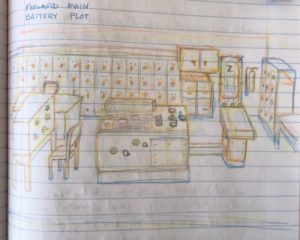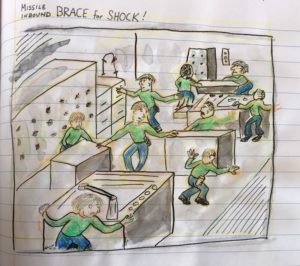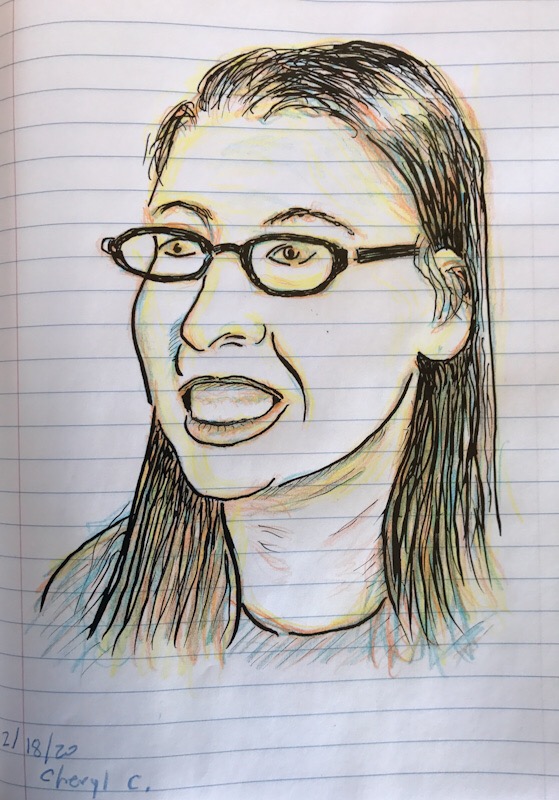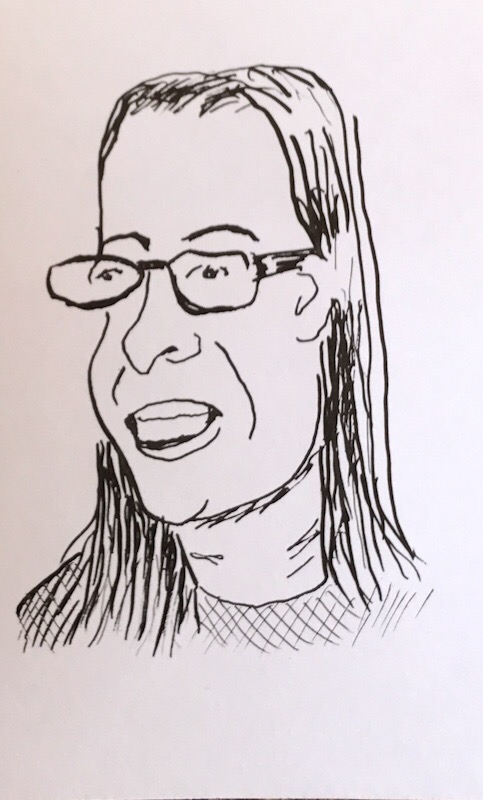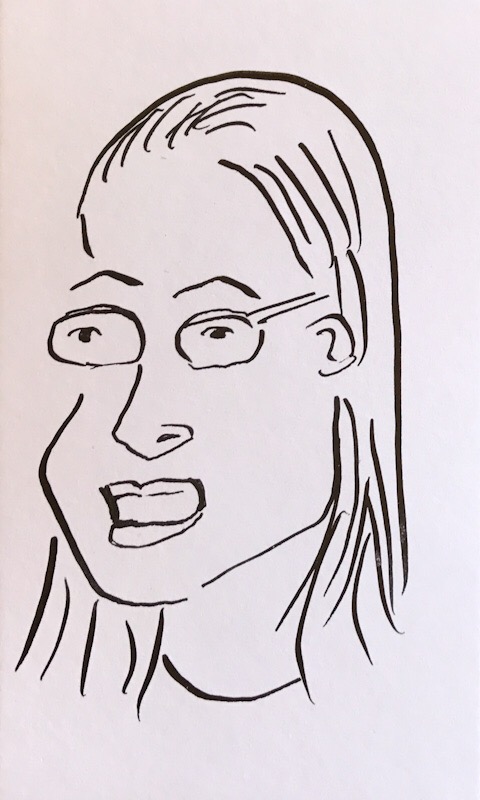A warm California summer memory on a cold Kansas February day.
Monthly Archives: February 2020
Up Storyboard
It's never too late to rewrite your Adventure Book. Happy 10th anniversary to Up. pic.twitter.com/hKMCKrghMz
— Pixar (@Pixar) May 29, 2019
Missile Inbound – Brace For Shock!
For regular visitors here, you may have seen some of my drawings from this memory of the first day of the ground war in Operation Desert Storm when Iraqi forces fired Silkworm anti-ship missiles at my ship. Here is a video that was recorded on 25 February 1991 around 0450 am.
This memory is forever embedded in my memory. If you have ever come face to face with your own mortality, perhaps through an accident or a close-call or, heaven forbid, the loss of a close loved one, you know these days.
I was deep inside of an armored WWII battleship. The plotting room is one of a battleship’s “vital organs” so to speak. It is the brains to the ship’s brawn, the 16″ guns. Without the computer equipment in this space, the ship cannot fight, so it is located deep inside the armored belt, right next to the engine spaces, meant to be safe from Japanese and German shells and torpedoes. Even so, with a missile bearing down on you and you can do nothing but stand there and take whatever is coming, you have to wonder if this could be the end?
Fortunately, our battlegroup had some missile destroyers along with us riding shotgun, and the HMS Gloucester shot down the one that came nearest to us. I’ll never forget the name of that ship either. (There is a lengthy article about the missile attack incident you can also read.)
Later in the video, you can see us putting on gas masks because we were warned that a gas attack was imminent. Missiles, now gas? At that point I was wearing a little protective box on my head, inside of a bigger protective box – the plotting room, inside of a bigger box – the armored belt, inside a still bigger box floating in the ocean – the battleship. Claustrophobia anyone?
Open and Networked Scholarship
Open and Networked Scholarship
#OpenEd #HEdigID #DigPed
https://t.co/D1T5qvesx3— Chris Rowell🌴 (@Chri5rowell) September 30, 2019
I have been doing it this way for a long, long time.
Fill-In-The-Blank Quizzes on Canvas
Teachers of English might find this amusing. I have been experimenting with using automated quizzes on Canvas. One form of quiz I have tried is “fill-in-the-blank.” For this type, you have to anticipate what correct answers will be provided by the students. If they type it in correctly, they will receive credit, but any slight deviation will be counted wrong.
So far, every single student who has taken my quiz has required a scoring adjustment because of weird capitalizations and punctuations or because they didn’t make the subject agree with the provided verb. (Why do you need to add “s” to everything???)
I’m doing the automated quizzes to save on grading work, but on this one, it so far has saved me nothing. But I’m remembering from my college days Dr. Les Hemphill, my psych teacher, set up a computerized testing system that was hard as hell, but he allowed you to re-take it as many times as you wanted to if you wanted a perfect score. Sneaky! We were reviewing the material over and over, doing it this way.
I could ditch the format altogether – probably the preferred path, or I could just have the quiz be very strict about what answers are acceptable and let them do re-takes. I have already adjusted the instructions to note that correct answers must be single-word answers that must agree with the verb used in the prompt sentence and that extraneous capitalization or punctuation will cause the answer to be marked incorrect. I also now allow unlimited re-takes of the quiz. It is already an open-notes quiz with no restrictions on group efforts.
Hmm. This could be frustrating for a student to encounter, to be sure. It feels like an automated version of Neil Postman’s “Guess what the teacher is thinking” game. But it is an extremely low-stakes quiz meant for reviewing material discussed in class. I don’t mean for it to be punitive. Keeping this format could serve as a not-so-subtle reminder that good grammar is something worth considering.
I’m still thinking about the nuances of this.
Battleship – Forward Main Battery Plotting Room
Cheryl Cartoon
This is a series drawn from a photograph of a woman I work with called Cheryl. She was very complimentary of the cartoons I’ve been posting on Facebook and wanted to know when she would get to see one of her. So this morning I drew this first one in my sketchbook from a news photo I found of her online. (She’s a rock-star around these parts!)

I used the 3-color technique that I’ve been practicing, first in yellow, followed by orange, then finally with blue. After this, you use black ink. Er, I guess that’s really four colors, isn’t it? Or is black a color? Oh well.
It is interesting how an image just appears when you follow that process. It reminds me a little of how an image magically appears on photographic paper in a darkroom. First, you can barely see it. Then it gradually becomes more clear. Finally, the image is complete.
After this sketch, I drew a series of other line drawings, working now from my sketchbook drawing instead of the original photograph. Unfortunately, I did not keep track of the order in which I made the sketches. I do know I started out drawing more detail and with each iteration, I tried going faster and with fewer details. So that is one explanation for why each one is unique and looks quite different from the others.
Esolen’ Influential Books
From Anthony Esolen’s post on Facebook today…
Not that anybody is wondering, but if you asked me what books have been of the greatest influence on how and what I think, aside from the BIBLE, and the plays of Shakespeare, I’d answer:
Homer, Odyssey
Plato, Phaedrus
Plato, Symposium
Virgil, Aeneid
Augustine, Confessions
Boethius, The Consolation of Philosophy
Anonymous, The Quest of the Holy Grail
Dante, The Divine Comedy
Spenser, The Faerie Queene
Herbert, The Temple
Pascal, Pensees
Milton, Paradise Lost
Fielding, Tom Jones
Boswell, Life of Johnson
Burke, Reflections on the Revolution in France
Manzoni, The Betrothed
Dickens, Bleak House
Dostoyevsky, The Brothers Karamazov
Marcel, Man Against Mass Society
Guardini, The End of the Modern World
Pieper, Leisure: The Basis of Culture
Lewis, The Abolition of Man
Kirk, The Conservative Mind
Muggeridge, autobiography
Lasch, Culture of Narcissism
Chesterton, The Everlasting Man
Emily Genereux Sings the National Anthem
Antiques Roadshow – Computer Edition
My students were testing out some new video streaming gear called Sling Studio, so we made this video of me talking about some antique computer stuff we have in the computer lab.

